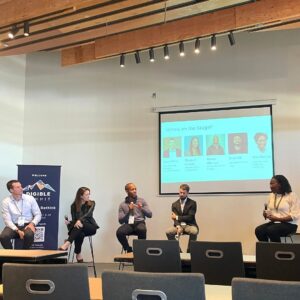Trying to make changes to your property’s tech stack in what seems to be an impossible timeframe? Not sure where to start or what technology to choose? Well, that depends on your goals, how you plan to use the technology and the complexity of your needs. We hear from experts in the multifamily industry about the vetting process to ensure that the right technologies are chosen, there is minimal conflict between existing systems, and you are positioned to get the most out of your investment.
Panelists
Aaron Maas, Executive Vice President of The Life Properties
Scott Hill, Co-Founder & CEO of PERQ
Remen Okoruwa, Co-Founder & CEO of Propify
Elizabeth Braman, Founder & CEO of RevolutionRE
Moderator: Khet Richards, Proptech Consultant
Evaluate Your Technology Stack
What is a Technology Stack? It is a set of tools that work together to achieve a common goal in the multifamily industry.
Whether that’s tracking leads to lease for prospects, communication with current residents, to data analysis to make informed decisions at the operational level and onsite level. Here are some key factors to consider when evaluating the technology and needs of the property management entity or portfolio.
- Data should tell the whole picture.
In other words, the whole ecosystem of multifamily marketing and operations rather than the silo approach. From marketing to onsite staffing, lease renewals, and day-to-day operations. - KPIs are King
Gathering clean and accurate data is crucial in any business model. In multifamily, understanding the lead to tour rate but also understanding the lead source. Your tech stack will want to measure KPIs while providing the data story and insights. In 2023, technology is rapidly iterating on current applications and the current use of data. You’ll want to ensure ROI and metrics are clearly communicated during the onboarding of any new technology.
Based on a poll to our audience at the Summit, a majority of marketers, vendors, and operators have 6 or more vendors in their prospect or resident tech stacks, are the key decision makers and users in their tech stack and many have neutral feelings about their tech stack. They don’t love it or hate it.
How to Start to Integrate New Solutions
Knowing where to start the process of integrating a new tech stack can seem daunting. Here are a few things to consider.
1. Do a pilot. Determine if this technology platform is a fit for your organization and team and accountability on each end.
2. Determine a 30, 60, 90-day success plan and define success.
3. Be concrete on who in the organization is touching this product and getting value out to ensure it will be actively deployed.
Integration in Multifamily
Some industries have ease of integration, such as banking, with a simple link to your bank for bill auto-pay. With multifamily there is not a lot of integration and bi-directional, and often no open API. The catch: API is good for bi-directional but not always raw data. It can be a messier user experience if trying to pump everything in one tech tool and integrate as some tools solve other goals and solutions to fit your organization’s needs.
The balance between humans and AI in the technology stack.
There’s a debate in multifamily if centralization and technology will replace human touchpoints. Not completely. When it comes to phone calls and conversations with future residents, give your onsite team time to have deeper conversations and have the technology to auto-do triggers and repetitive tasks, therefore, freeing up time for the onsite team to leverage that human connection. Encourage self-serve in the consideration process, like scheduling a time with us or a tour.
Manage AI like an employee, not lose insight from humans, and be intuitive when future residents want to speak or engage with a human.
Unlearn and Rethink Your Tech Stack
Rethink: KPIs and conversion ratios don’t tell the time frame.
Reevaluate: The workflow of how you’re thinking of the marketing strategy. Such as Website conversion, hitting the bottom of the funnel, and rethinking that conversion strategy and tools.
Reassess: Lead management strategy database and nurture techniques and larger lead pool. Rethink what other industries have proven.
Unlearn long-term. Sometimes better to commit month-to-month rather than longer-term as you have flexibility in case you hit challenges in the product and the Extract Transform Load (ETL).

Next Steps with Your Technology Stack
1. Before onboarding with any Technology Stack, evaluate your company’s KPIs and data to measure synchronous data storytelling in the multifamily ecosystem, both marketing and operations.
2. Integrate new technology and solutions with a pilot, 30-90 day success plan, and be concrete on team members that will be actively using this technology.
3. AI and human connection. And is a bridge. Or is a barrier. But is a barrier. Ensure there is a balance of AI technology and human connection with residents and prospects to build lasting trust and meet your future residents where they are at in the consideration phase.
Technology is not here to replace us humans. It’s to make marketing and operations efficient, and scalable, and measure success in the multifamily industry, whatever success may look like for your company. Yes, some of us have 6 or more tech stack vendors, but understanding the best technology to suit your needs and measure KPIs. Technology is here to keep us curious, keep us questioning, and keep us learning.










